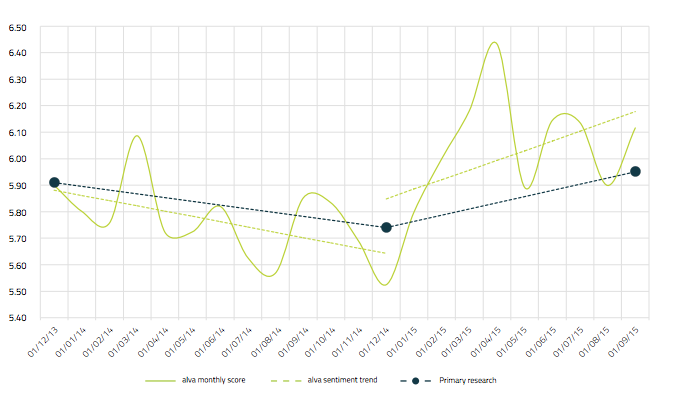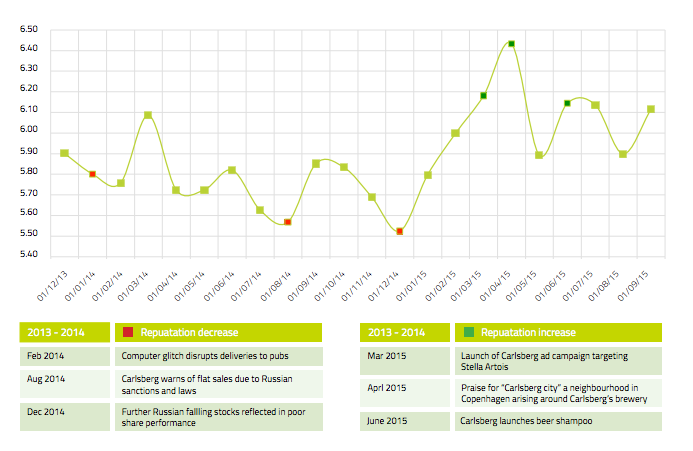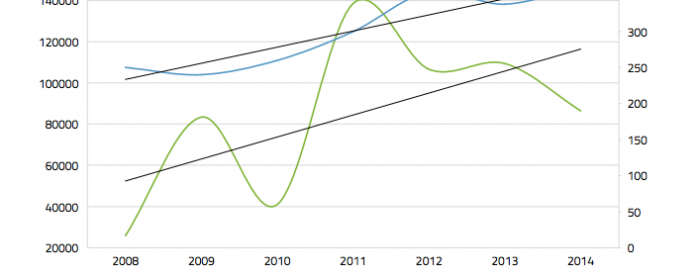Managing an evolving corporate reputation: Carlsberg Case Study
Now that there is growing recognition that a positive corporate reputation and commercial success go hand in hand – and, by implication, a poor corporate reputation can negatively impact commercial performance – many organisations are wrestling with how best to get closer to understanding and shaping their evolving reputation.
For management teams who are committed to understanding more about their corporate reputation and embedding it within their organisation, the combination of primary research and ongoing content analytics provides a comprehensive toolkit which will assist in ensuring that measuring reputation is not a one-off, but can develop into a dynamic item on the strategic agenda.
The corporate reputation landscape
2015 was another year when many companies and organisations had to confront and handle challenging issues, some of which have resulted in deteriorating commercial and/or share price performance. Once again, in many cases, it will take years to restore confidence and trust among stakeholders and rebuild an organisation’s reputation.
Research of FTSE 350 companies, undertaken by SIFA Strategy in 2015 in partnership with Deloitte LLP, confirmed that 97% of respondents agreed that company reputation held commercial value. 38% confirmed that their organisations had witnessed a damaging event in the last five years, but only 16% stated that they actively measured their reputational performance. This appears to be an interesting conundrum: management appreciate that corporate reputation needs to be taken seriously but for one reason or another, this does not always translate into proactive measurement, monitoring and analysis of an evolving company reputation.
The tendency is for some organisations to adopt a more reactive approach: identify and rank key risks to its reputation and then prepare for such risks to become reality.
The organisations which tend to be more proactive are those who have already had their corporate reputation damaged and have decided to look after their reputation in a more structured way. Or, they are organisations that are very much in the public eye, are consumer-facing; regulated; or are involved in industry sectors that are taking steps to improve their overall company reputation.
For those who do decide to measure their evolving corporate reputation, the next question is what approach to take.
Reputation measurement: an historic perspective
Before the rise of technology facilitated a greater interconnectedness of stakeholders, different proxies for reputation were developed based on the stakeholder in question: investor relations would look at share price and analyst ratings to understand investor sentiment; HR would hold annual employee engagement surveys to understand the employee perspective; marketing and customer experience would have customer feedback surveys and Net 3. Promoter Scores; while Communications and Corporate Affairs tended to rely on media analysis to take the pulse of the media and public landscapes.
These proxies were adequate measures when it was possible to neatly segregate stakeholder groups. This was because each stakeholder group had its own interests and expectations which, by and large, existed in isolation from those of other stakeholders. This enabled companies to approach these stakeholders in very different ways and indeed led to the creation of separate siloed functions to deal with them.
With the advent of digital media and communications, we have witnessed an ever-increasing interaction between stakeholder groups and a consequent greater blurring of the boundaries between the interests, expectations and needs of different stakeholders. As information becomes more freely available, this segregated model of reputation proxies using different metrics and reporting on different frequencies is no longer fit for purpose.
Primary research and content analytics
Primary research plays an important role by enabling a company to engage directly with a range of informed stakeholders to bring their perspectives and opinions to the attention of the organisation. Essentially, primary research allows organisations to put a marker in the ground, providing the necessary data and feedback with which management can help to build and improve corporate reputation. Typically, primary research is undertaken on an annual basis, so that information gap needs to be filled if reputation is to become an important business tool which can be tracked and managed on an ongoing basis. Thankfully, content analytics can now fill that void.
This is the era of big data and publicly-available content provides organisations with a wealth of direct and indirect stakeholder perceptions that can be interrogated and analysed to understand shifts in sentiment for companies, issues and stakeholders over time. This content analytics includes the analysis of traditional media (print, broadcast, online and subscription sources), social media (Twitter, blogs, forums and social networks), surveys and analyst reports.
By joining up these two methodologies, organisations can now receive one standardised scorecard, which combines the benefits of the speed, breadth of sources and statistical rigour of the content analytics, with the direct experience, qualitative input of the primary research.
Case study: Carlsberg Group
Carlsberg Group took the decision to undertake primary research across all its key stakeholders – analysts, investors, retailers, wholesalers, consumers, politicians, NGOs, media and employees.
By conducting quantitative research across all these stakeholders, Carlsberg was able to gain valuable insight into how its corporate reputation was viewed on a variety of themes. In the case of Carlsberg, these included products, innovations, R&D, strategy, management, financial performance, organisational capability, employer branding or social responsibility. These were all considered to be market aspects that impacted on Carlsberg’s reputation.
Carlsberg rolled out this research across its largest 12 markets. The integrated metrics generated were helpful in guiding business planning, influencing business actions, developing key performance indicators and ultimately, linking remuneration to company reputational performance.
When considering reputation, the challenge is to establish a framework that sets the results in context, so the research programme can be extended to qualitative feedback and benchmarking against peers and peer sectors.
The solution is to have in place effective ongoing reputation intelligence that complements and is statistically aligned to the primary research. The question of alignment is an important one. For an organisation to actively measure and manage its evolving corporate reputation, it needs to be able to have access to robust data, both primary and thirdparty, which complements rather than contradicts.
alva and SIFA mapped three years’ historical primary research on Carlsberg against publicly-available content analytics gathered by alva. The latter includes the aforementioned sources such as print media, broadcast media, online media, blogs, micro-blogs, forums, podcasts, social networks, social photo, social video, wiki, financial analysis, political commentary, analyst notes in order to provide as full a picture as possible.
Correlating primary research and content analytics
To attempt the correlation between the content analytics and the primary research, alva compared its own content analytics data over a 22-month period with primary research commissioned by Carlsberg Group. The sample was restricted to data/responses from the United Kingdom only. The sample size for the alva content analytics was 3.2m pieces of content.
The 0-100 scoring range of Carlsberg’s primary research was re-baselined to the alva 1-10 scale and the scoring ranges normalised to align score distributions.
Prior to undertaking the regression analysis, alva created three hypotheses:
- There would be a statistically significant correlation between the primary research and content analytics •
- The alva content analytics would provide a leading indication of changes in the primary research data •
- By extension, alva’s content analytics can be used as an alerting mechanism for the earlier intervention and management of emerging reputational risks A
Hypothesis 2: The alva content analytics provides a leading indication of changes in the primary research scores
With the correlation established, we can now look to understand whether one data set foreshadows the other. In the example reviewed, the trendlines for the alva content analytics pre-empted the ultimate changes in primary research scores. This can be clearly seen in Figure I. The greater number of data points provided by the content analytics (daily scores) in combination with the positive correlation means an executive reviewing the data would be able to predict the movements in primary research scores in advance of their publication.
Figure I: Primary research vs content analytics: Carlsberg
Figure II: Issues analysis of Carlsberg’s evolving corporate reputation

This helps to offset some of the understandable limitations of primary research. While primary research is important to engaging directly with stakeholders on the subject of an organisation’s reputation, a full survey tends to be carried out annually – or possibly every six months – which means that there can potentially be an information gap for much of the year. With content analytics added into the equation, this gap is removed.
Hypothesis 3: alva’s content analytics can be used as an alerting mechanism enabling the earlier intervention and management of emerging reputational risks.
Drilling deeper into the content analytics, it is possible to understand on a daily, weekly, monthly or quarterly basis the directional trend for the company’s reputation and, most importantly, the events and issues that are causing changes in corporate reputation.
Figure II shows high level examples of some of the issues driving Carlsberg’s scores over the period analysed. These graphs provide a month-by-month view but it is equally possible to zoom into a daily or weekly perspective, by stakeholder and issue.
Given the close correlation between the two data sets, executives can therefore assess the need to respond to emerging risks by the strength of the score changes in content analytics, measure performance relative to competitors as well as analysing the success or otherwise of their response. Being on top of the issues and having a consistent way of measuring their impact is key to an effective reputation management strategy.
Download the full Carlsberg Case Study to discover how this robust, always-on, comprehensive approach to reputation is helping leading global companies.
Business application – key takeaways
As businesses increasingly recognise that a positive corporate reputation and commercial success go hand in hand, it is becoming ever more urgent for management teams to embed an enterprise-wide reputation analysis system.
Instead of being a direct choice between content analytics and primary research, alva and SIFA have developed a pioneering way of combining the two methodologies, enabling the creation of a robust, alwayson, comprehensive approach to reputation. This white paper establishes the following findings:
Companies need to start taking action on reputation: While 97% of FTSE 350 companies believe reputation holds commercial value only 16% stated that they actively measured their reputational performance
Media analysis is no longer fit for purpose: Traditional, single channel reputation proxies (such as media monitoring) are no longer fit for purpose in today’s multi-stakeholder 24/7 environment
Content analytics and primary research are complementary measures: alva and SIFA have established a positive correlation between content analytics and primary research data enabling companies to respond more quickly to emerging threats to reputation
A joined-up approach provides better insight: combination of primary research – to understand the key issues and drivers of company reputation across multiple stakeholders – and content analytics – enabling real-time monitoring and analysis of shifting stakeholder perceptions over time – provides a new holistic framework for measuring an evolving reputation
Boards can now proactively manage an evolving reputation
With a comprehensive way of analysing reputation now established, boards have a robust measure available to help protect and build the commercial value of their organisation.
Authors
Alastair Pickering is co-founder at alva, the market leader in reputation intelligence; alva monitors and analyses millions of pieces of publicly-available content every day, to inform organisations how their business is perceived by their stakeholders. alva currently works with 35% of the FTSE100.
Fergus Wylie and Ben Morton are co-founders of SIFA Strategy, a senior advisory business that supports organisations in understanding what influences and shapes their reputation. SIFA Strategy’s approach is underpinned by the use of bespoke stakeholder research and analytics to measure reputational performance, to embed reputation and to enhance stakeholder value.
For further information
alva Alastair Pickering
+44 (0)7590 763 132
alastair.pickering@alva-group.com
SIFA Strategy
Ben Morton
+44 (0)7899 792902
ben.morton@sifastrategy.com
Be part of the
Stakeholder Intelligence community








